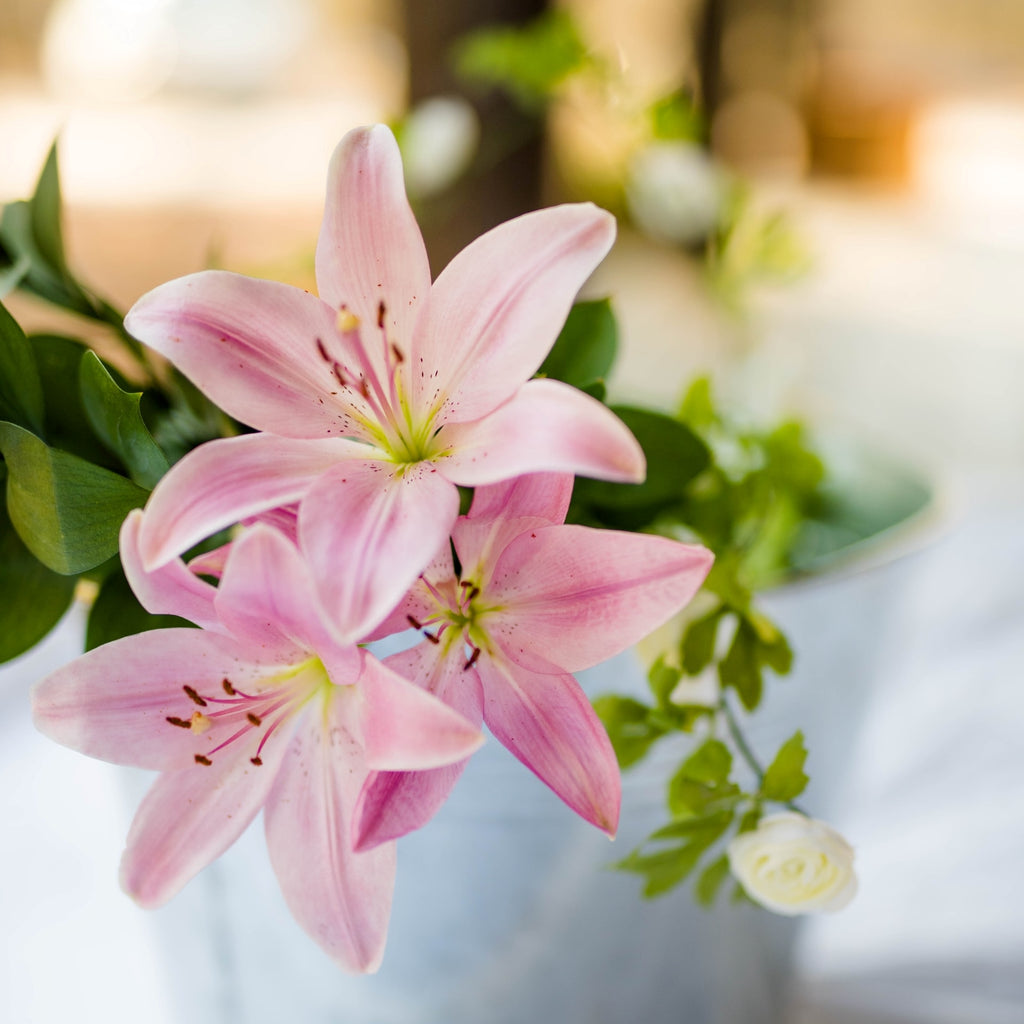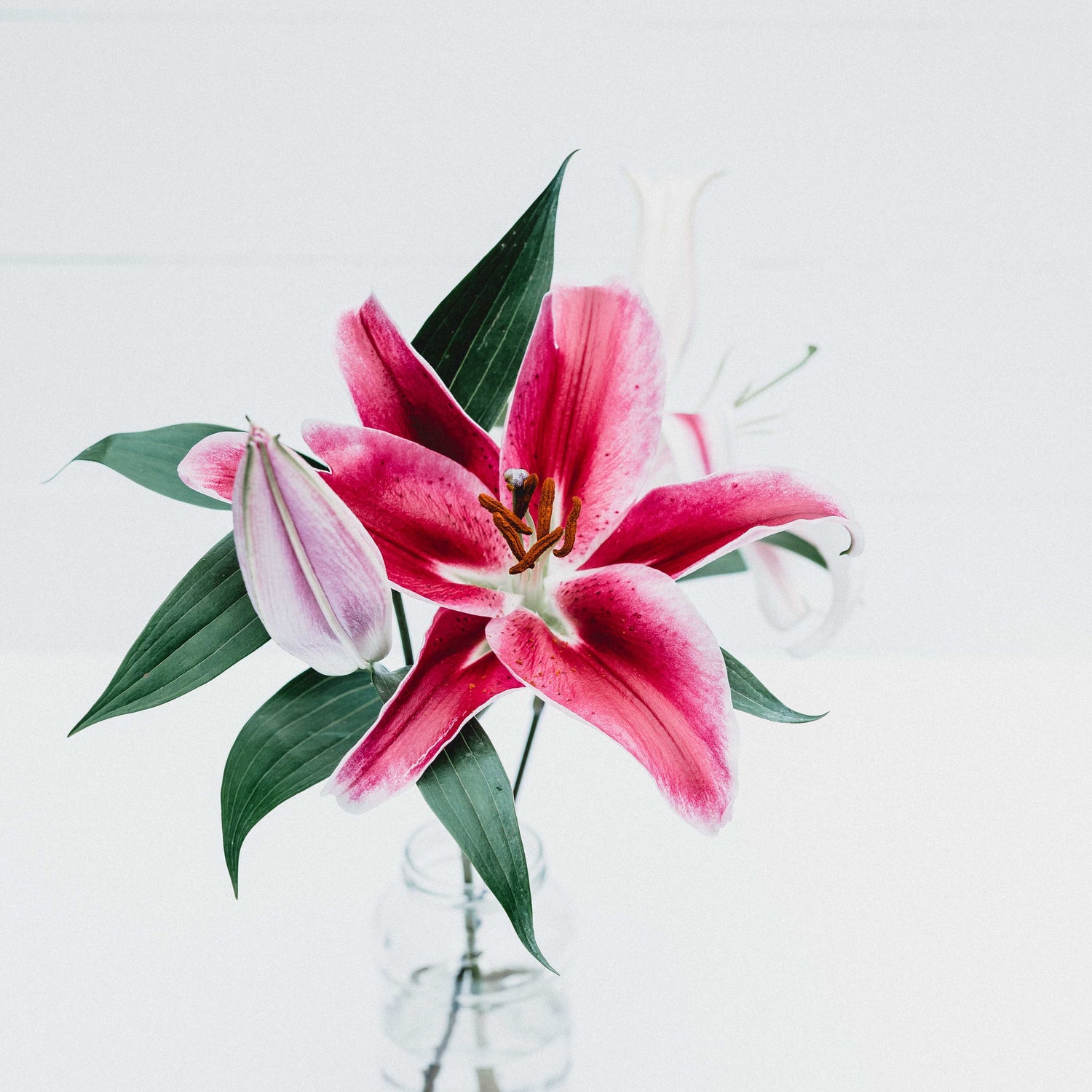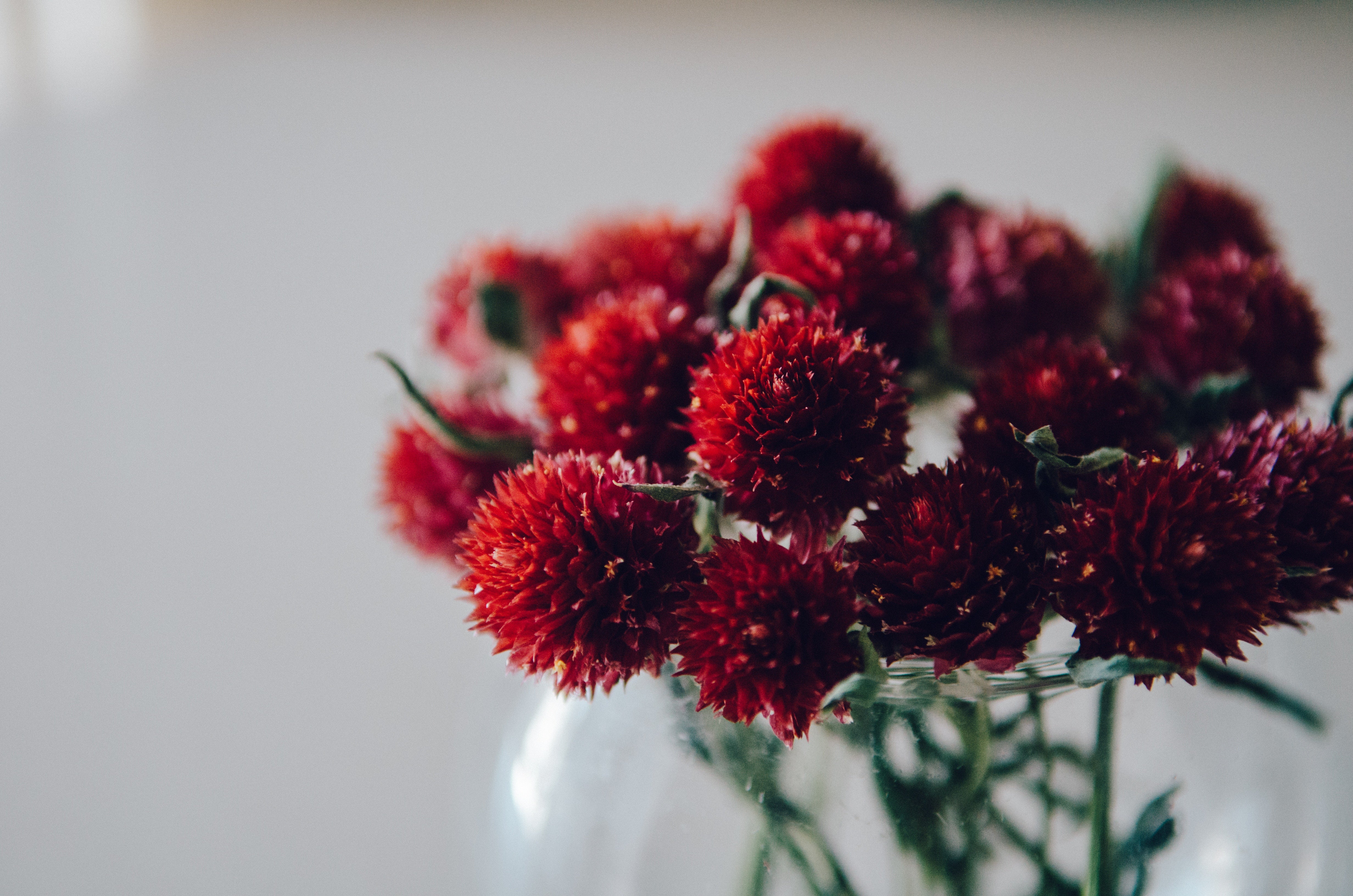We love our furry friends even more than we love our blooms, so we know how curious they can be around just about any new thing we might bring home. Seemingly every new shoe, bag or ball gets sniffed, licked and even chewed on!
My cat especially loves playing with (read: destroying) flowers. We put them on a high shelf out of reach, but somehow she will always find a way to get to them.
Unfortunately, a lot of our favourite blooms are actually toxic to cats and dogs.
Pet-parents can all agree that the safety of our fur babies is a top priority. It’s vital to know which flowers can harm pets and to be aware of the signs of ingestion.
Signs of poisoning can vary greatly, ranging from rashes and vomiting all the way to convulsions and even death. If ingestion and poisoning do occur, quick action is essential.
At Floraly, we want you to order flowers with complete peace of mind. We’ve put together a list of some of the most toxic flowers for pets so that you can choose the safest options for your fur babies.
Popular Flowers that are Toxic to Cats & Dogs
Let's begin with flowers that are commonly found all over Australia. You’ll find these in lavish bouquets as well as in people’s homes.
Considering the ubiquity of some of them, you’ll be surprised to know these flowers are poisonous to cats and dogs. Make sure to keep your pets away from them.
Lilies

These gorgeous flowers are a timeless gifting option. But when you ask a cat-owner “what flowers are poisonous to cats?” most will be able to give you at least one answer straight away: lilies.
Of all flowers highly toxic to cats, lilies are perhaps the worst and the most infamous.
Not just the petals, but the stem, the leaves, and even the water in which the plant is kept, are poisonous to cats.
Because of this, we highly discourage cat-owners from keeping lilies in their homes.
Signs of lily poisoning may include depression, lethargy and vomiting. If untreated, renal failure may occur.
While lilies aren’t as dangerous for dogs, certain varieties are still highly toxic to them and can cause severe gastrointestinal upset and tremors if a large amount is ingested.
Tulips

These members of the lily family are widely loved for their springtime cheer, bright colours and hardiness. But are tulips safe for cats?
Unfortunately, no. Tulips are as toxic as lilies to cats. Not only that, but these flowers are poisonous to dogs as well as horses.
They contain Tulipalin A, a natural compound that's found all throughout the flower, but in especially high concentrations in the bulbs.
Ingestion can cause gastrointestinal discomfort, vomiting, depression, diarrhoea, and hypersalivation in cats, dogs and horses.
For those who don't have pets, tulips are one of the most popular flower choices. You can learn more about tulips in our blog post.
Chrysanthemums

Chrysanthemums are also among the list of popular flowers that are poisonous to dogs and cats.
They contain a number of potential irritants, including lactones and pyrethrins. Symptoms of ingestion include gastrointestinal discomfort, dermatitis, vomiting, diarrhoea, drooling, and a lack of coordination.
Amaryllis

While they closely resemble lilies, amaryllis are not a part of the lily family. However, like lilies, they also make it onto the list of flowers toxic to dogs and cats.
If consumed, this beautiful bulb can cause abdominal pain, tremors, diarrhoea, and hypersalivation in both cats and dogs.
Daffodils

These cheery yellow perennial favourites also make it onto the list of poisonous flowers for dogs, cats and horses.
Not just the flower, the whole plant is toxic, the bulb especially so.
Lycorine, an alkaloid present in daffodils, can trigger vomiting, while crystals in the outer layer of the bulbs are severely toxic and can cause serious conditions such as cardiac arrhythmia, low blood pressure, seizures and laboured breathing.
Poppies

One of our favourite winter blooms, poppies are beautiful and full of character. They are also among the most toxic flowers for dogs and cats.
Poppies contain alkaloids and opioids, the kinds and quantities of which differ between species.
Some particularly potent varieties can affect your pet’s central nervous system. Symptoms include dilated or pinpoint pupils, euphoria, drowsiness, dizziness, loss of appetite, and even coma.
Hyacinths

These pretty springtime flowers are toxic to cats, even from simply inhaling them. Ingesting a hyacinth bulb can result in drooling, vomiting, or diarrhoea.
Consuming a large amount can cause severe symptoms such as an increase in heart rate, violent tremors, changes in respiration, and breathing difficulties.
Peonies

Who can resist a sweet-smelling peony in full bloom? A popular choice for birthday bouquets, these flowers are also toxic to cats and dogs.
Peonies contain paeonol, a toxin known to be harmful to both cats and dogs.
If ingested, peonies can cause mild to moderate poisoning. Some common signs to watch for would be gastrointestinal upset, vomiting, and diarrhoea.
Dahlias

These bright summertime blooms look stunning in our gardens and make wonderful additions to our bouquets.
But unfortunately, these flowers are toxic to cats.
While not nearly as toxic as some of the other flowers on this list, dahlias can cause mild gastrointestinal upset and skin irritation in both cats and dogs. Be on the lookout for non-stop scratching, fur loss and runny bowel movements.
Wisteria

These enchanting blooms hang down from their branches like curtains, looking like something out of a fairy tale.
Pretty though they may be, they are also somewhat poisonous to cats and dogs.
Wisteria poisoning symptoms may vary depending on the amount and parts consumed. The seed pods in wisteria plants contain high levels of lectin and wisterin toxins that can cause serious gastrointestinal symptoms, some of which may be fatal.
Azaleas & Rhododendron

Grayanotoxin located in the leaves, petals and even pollen of azaleas can cause digestive problems, excessive drooling, weakness, and loss of appetite when ingested.
In high amounts, this may cause seizures and even lead to a coma.
Plants that are Toxic to Cats & Dogs
Unfortunately, it's not only flowers that are toxic to our pets. A variety of common plants, succulents and trees are also poisonous to cats and dogs.
Aloe Vera

We love aloe vera for its health benefits, but the latex it produces can be toxic to your pet.
This latex contains anthraquinone glycosides, which encourage bowel movements. Ingestion can cause vomiting and diarrhoea, which may in turn lead to dehydration.
Eucalyptus

While koalas love munching on them, eucalyptus leaves are toxic to dogs, cats and horses.
Eucalyptol, the chemical present in the leaves and the bark of eucalyptus trees, is a neurotoxin and gastrointestinal irritant.
Symptoms of ingestion may include vomiting, diarrhoea, loss of appetite, difficulty swallowing, dilated or pinpoint eyes, general weakness and excessive salivation. It can also cause seizures if consumed in large quantities.
Make sure you keep your fur babies away from any products containing eucalyptus oil, too. This may include aromatherapy oils, cleaning products and beauty products.
Philodendrons

A number of popular house plant varieties belong to this genus of plants, including fiddle leaf figs and monstera.
Thankfully, they are only mildly toxic to dogs and cats.
The sap contains calcium oxalate crystals, which can irritate the mouth, throat and stomach if ingested.
Other plants that contain oxalate crystals include ZZ gems, calla lilies and pothos. Like philodendrons, they belong to the Araceae plant family.
Other Common House Plants that are Poisonous to Cats & Dogs

- Ammi
- Clematis
- Monkshood
- Iris
- Asparagus Fern
- Tanacetum
- Yew
- Autumn Crocus
- Lantana
- Anthurium
- Caladium
- Bird of Paradise
- Delphinium
- Boxwood
- Hydrangea
- Morning Glory
- Gladiola
This is only a partial list of plants that are toxic to cats and dogs. For a more detailed list of flowers, plants and substances which are toxic to pets, visit the Pet Poison Helpline, Top Dog Blog or speak to your vet.
What to Do if Your Dog or Cat has Ingested a Toxic Plant or Flower
Now that you know which plants and flowers are toxic to cats and dogs, you can be extra cautious of bringing them into your home.
If you suspect your pet has ingested any potentially harmful flowers or plants, we advise contacting your vet immediately for professional advice.
The veterinarian will need details about when your pet ate the plants, how much was consumed, and the symptoms you have observed. It would also help if you brought along the flowers that may have caused the problem.
Protecting your Pets from Toxic Plants
Dogs and cats are such curious creatures. We recommend keeping your flowers out of their reach and being especially careful around the flowers and plants listed above.
Tulips, lilies, chrysanthemums and other beautiful flowers can still be enjoyed in a pet-friendly household, just as long as you know the risks and keep them out of reach of your pets.
Pet-Safe Flowers & Plants
While it may seem like a large number of plants and flowers are toxic to dogs and cats, there are still plenty of safe options that pet mums and dads can enjoy.
Here are some pet-safe flowers and plants you can send to your family and friends with cats and dogs, or enjoy in your own home with peace of mind.
Roses

Thankfully, the most romantic of blooms is considered to be among flowers safe for dogs and cats. These elegant flowers are available all year round, and are always a safe option to send to your pet parent friends and family.
Check out our blog to learn more about different colours of roses and what they mean.
Just remember to watch out for thorns!
Sunflowers

Just when we thought we couldn't adore sunflowers any more, we have one more reason to. These iconic yellow blooms make a delightful gift and are also a safe choice for cat and dog owners.
Alstroemeria

These are also known as Peruvian lilies, so it may come as a surprise to learn that these flowers are safe for cats, dogs, and horses!
Available in a variety of lovely colours, you'll find alstroemeria as a filler flower in several of our bouquets.
Phalaenopsis Orchids

Otherwise known as moth orchids, these elegant blooms look wonderful in a little pot, are long-lasting and make a really great present.
Another great thing about them is that these flowers are safe for dogs and cats! Win!
Snapdragons

These cool-sounding blooms are safe for cats and dogs. Their natural growing season is from winter to spring, and they come in a variety of stunning colours.
Spider plants

These are non-toxic to both cats and dogs, so no worries if your pet accidentally nibbles on them!
These plants also grow really well in hanging baskets, so you can easily keep them up high and safely out of reach of curious kitties.
It is, however, worth noting that some suspect spider plants of causing a mild hallucinogenic effect in felines, similar to that of catnip. While this is not thought to be harmful, it may result in some different behaviour from your cat.
Other Pet-Safe Flowers & Plants
- African Violets
- Gerbera Daisy
- Areca Plant
- Swedish Ivy
- Prayer Plant
- Blue-Eyed Daisy
- Creeping Zinnia
- Marigolds
- Blazing Star
Which Floraly Bouquets are Safe for Pets?
A word of caution: none of our Floraly bouquets are designed to be eaten—by humans or pets.
Even if the flowers are technically safe to eat (such as kale flowers, roses, and even sunflowers), they may contain pesticides or fungicides, which can be harmful if ingested.
To be absolutely safe, we recommend displaying your flowers out of reach of pets. Should your pet ingest any flowers—even if you only suspect they may have eaten some—we advise you to contact your vet immediately to ask for their professional advice.
When buying or gifting bouquets for someone else, it is important to be extra careful about flower selection and to know what flowers are toxic to cats and dogs.
Consider purchasing one of the flower varieties listed above that is pet-safe, or reminding your recipient to keep them in a safe spot where their pet can't get to them.
Armed with this important information about which flowers are safe for dogs and cats, and which ones are not, you can explore our range of fresh and beautiful flower bouquets with confidence and peace of mind.
Or you can explore our Flower Delivery Melbourne, Flower Delivery Sydney and Flower Delivery Perth collections to see what flowers we can deliver to your loved ones in these locations.


